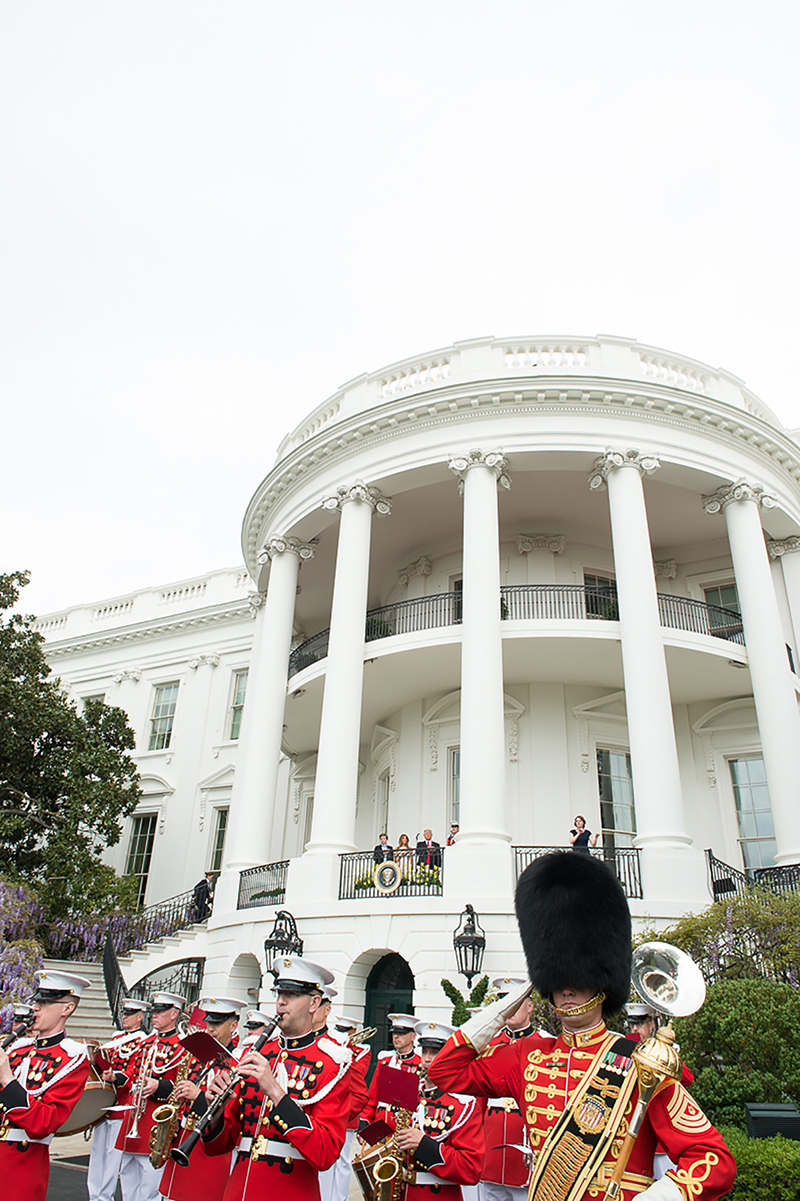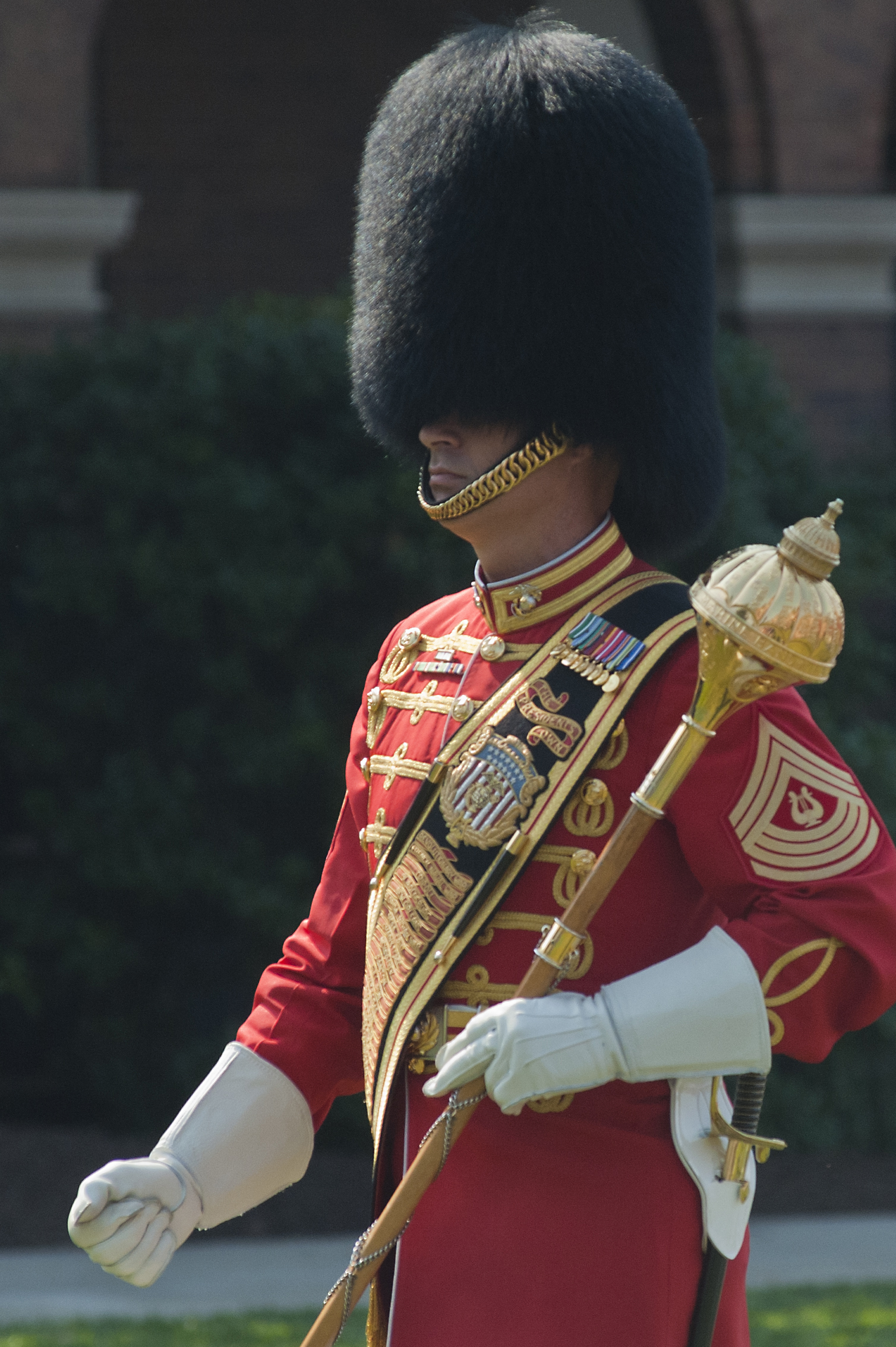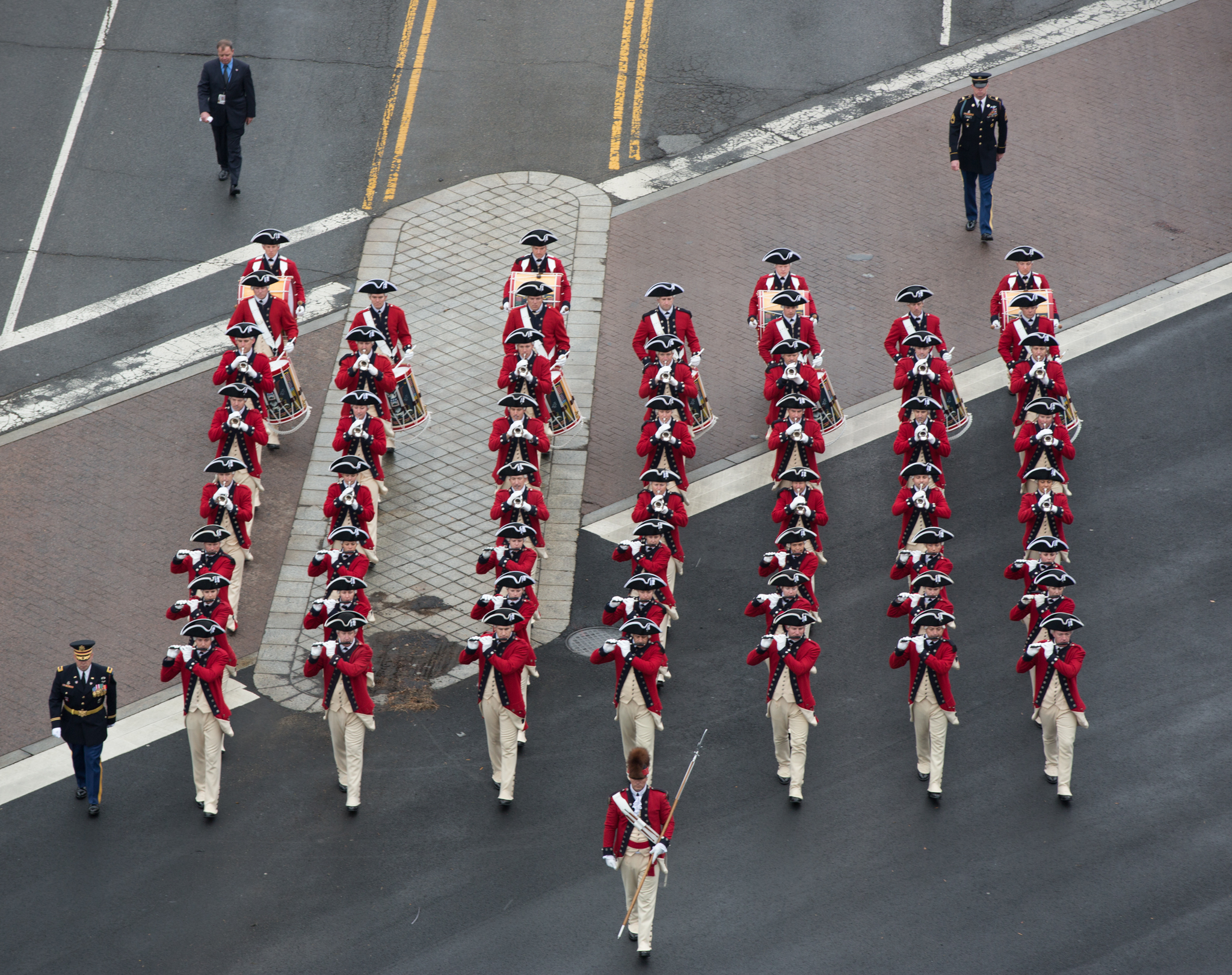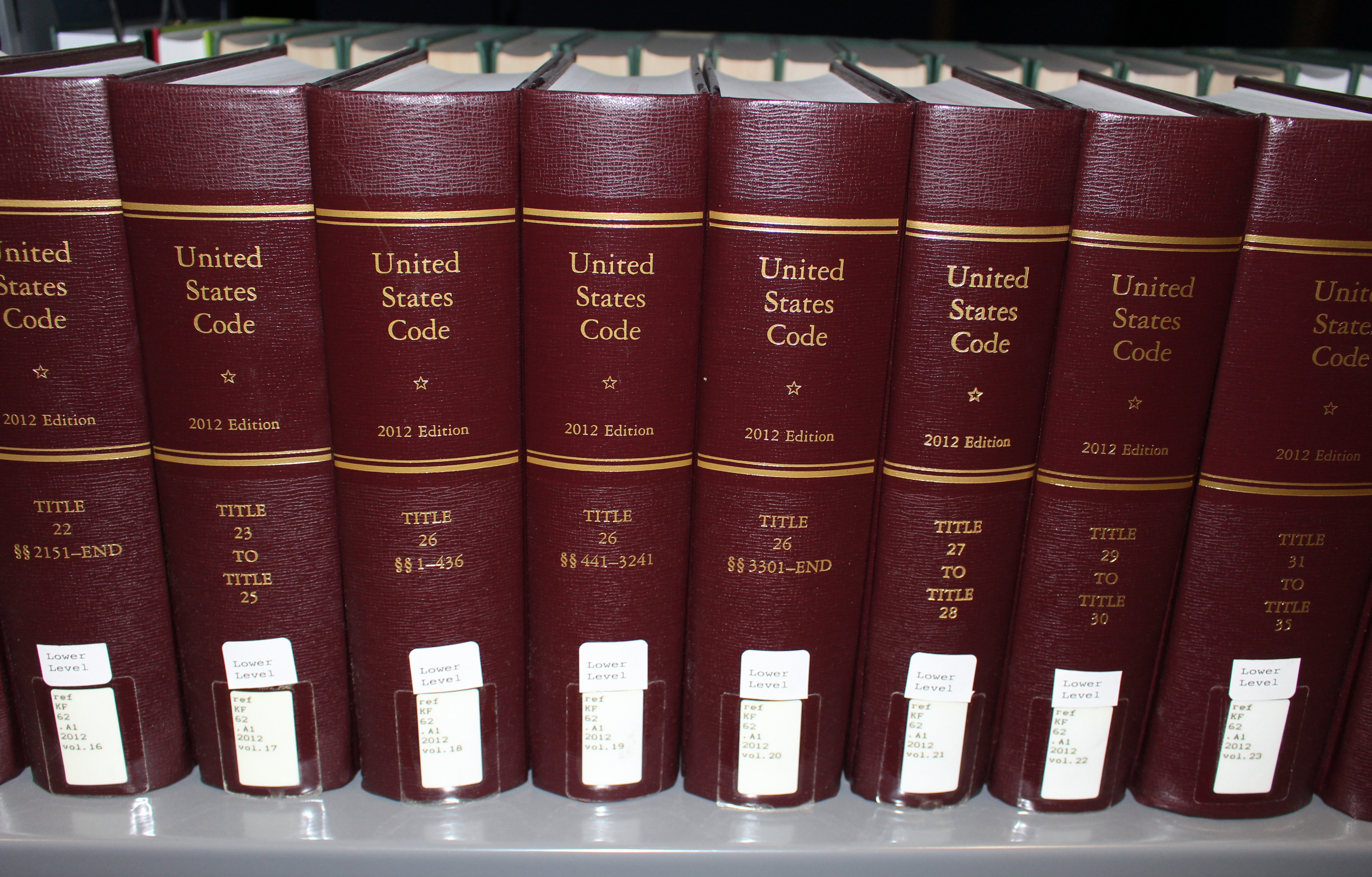|
United States Military Music Customs
United States military music customs are the traditional, regulatory, and statutory provisions that guide performances by United States military bands during drill and ceremony and state occasions. History and evolution For hundreds of years, military forces have used music to signal their troops. The use of music retains an important place in modern diplomatic protocol and military courtesy and is part of many official military events, such as state funerals, military parades, naval christening, officer-commissioning ceremonies, and promotion ceremonies. Unlike other English-speaking nations, United States military band ceremonial music is not largely drawn from British military customs but is, rather, a mix of original styles and compositions and - to a lesser extent - French traditions. At the outset of the American Revolution, United States military units primarily relied on fife and drum corps for musical support. The U.S. was first introduced to the bugle horn (forerunner ... [...More Info...] [...Related Items...] OR: [Wikipedia] [Google] [Baidu] |
United States Military Bands
United States military bands include musical ensembles maintained by the United States Army, United States Marine Corps, United States Navy, United States Air Force, and United States Coast Guard. More broadly, they can also include musical ensembles of other federal and state uniformed services, including the Public Health Service and NOAA Corps, the state defense forces, and the senior military colleges. During the colonial period, most British army units posted in the area that would become the United States had bands attached. The first recorded instance of a local American military band was in 1653 in the New Hampshire militia. The oldest extant United States military band is the United States Marine Corps Band, formed in 1798 and known by the moniker "The President's Own". The U.S. armed forces field eleven ensembles and more than 100 smaller, active-duty and reserve bands. Bands provide martial music during official events including state arrivals, military funerals, ship ... [...More Info...] [...Related Items...] OR: [Wikipedia] [Google] [Baidu] |
Old Guard Fife And Drum Corps
The United States Army Old Guard Fife and Drum Corps is one of four premier musical organizations of the United States Army. Members perform using musical instruments and wearing uniforms similar to those used by military musicians of the Continental Army during the American Revolution. It is the only unit of its kind in the United States' armed forces, and is part of the 3rd U.S. Infantry ("The Old Guard"). The Fife and Drum Corps has been stationed at Fort Myer, Virginia, since its founding on February 23, 1960. In 2022, February 18th was named “The United States Army Old Guard Fife and Drum Corps Day” in Spanish Fort, Alabama. Musicians The musicians of this unit recall the fifes and drums from the days of the American Revolution as they perform in uniforms patterned after those worn by the musicians of Gen. George Washington's Continental Army. Military musicians of the period wore the reverse colors of the regiments to which they were assigned. The uniforms worn ... [...More Info...] [...Related Items...] OR: [Wikipedia] [Google] [Baidu] |
To The Color
"To the Colors" is a bugle call honoring the United States used when there is no band present, when the national anthem (The Star-Spangled Banner) cannot be played or when the national anthem has been played already but honor is to be rendered again. The United States Armed Forces requires the same courtesies to "To the Colors" as to the national anthem. Note that the call To the Colors is named and employed differently between US Military Branches. In the US Army, To the Colors is sounded at the moment the flag begins to be ''lowered in the evening'', and is immediately preceded by "Retreat" which marks the end of the working day. In the US Navy, "Morning Colors" (the same call as To The Colors) is sounded the moment the flag is ''raised in the morning''. The previously mentioned Retreat is named "Evening Colors" by the US Navy, and is played by itself. See Manual for Buglers, U.S. Navy, articles 35 and 75 pertaining to Morning and Evening Colors calls. In the Boy Scouts ... [...More Info...] [...Related Items...] OR: [Wikipedia] [Google] [Baidu] |
Cadence (music)
In Western musical theory, a cadence (Latin ''cadentia'', "a falling") is the end of a phrase in which the melody or harmony creates a sense of full or partial resolution, especially in music of the 16th century onwards.Don Michael Randel (1999). ''The Harvard Concise Dictionary of Music and Musicians'', pp. 105-106. . A harmonic cadence is a progression of two or more chords that concludes a phrase, section, or piece of music. A rhythmic cadence is a characteristic rhythmic pattern that indicates the end of a phrase. A cadence can be labeled "weak" or "strong" depending on the impression of finality it gives. While cadences are usually classified by specific chord or melodic progressions, the use of such progressions does not necessarily constitute a cadence—there must be a sense of closure, as at the end of a phrase. Harmonic rhythm plays an important part in determining where a cadence occurs. Cadences are strong indicators of the tonic or central pitch of a passage or ... [...More Info...] [...Related Items...] OR: [Wikipedia] [Google] [Baidu] |
Retreat (bugle Call)
A bugle call is a short tune, originating as a military signal announcing scheduled and certain non-scheduled events on a military installation, battlefield, or ship. Historically, bugles, drums, and other loud musical instruments were used for clear communication in the noise and confusion of a battlefield. Naval bugle calls were also used to command the crew of many warships (signaling between ships being by flaghoist, semaphore, signal lamp or other means). A defining feature of a bugle call is that it consists only of notes from a single overtone series. This is in fact a requirement if it is to be playable on a bugle or equivalently on a trumpet without moving the valves. (If a bandsman plays calls on a trumpet, for example, one particular key may be favored or even prescribed, such as: all calls to be played with the first valve down.) Bugle calls typically indicated the change in daily routines of camp. Every duty around camp had its own bugle call, and since cavalry h ... [...More Info...] [...Related Items...] OR: [Wikipedia] [Google] [Baidu] |
Reveille
"Reveille" ( , ), called in French "Le Réveil" is a bugle call, trumpet call, drum, fife-and-drum or pipes call most often associated with the military; it is chiefly used to wake military personnel at sunrise. The name comes from (or ), the French word for "wake up". Commonwealth of Nations and the United States The tunes used in the Commonwealth of Nations are different from the one used in the United States, but they are used in analogous ways: to ceremonially start the day. British Army Cavalry and Royal Horse Artillery regiments sound a call different from the infantry versions, known as "The Rouse" but often misnamed "Reveille", while most Scottish Regiments of the British Army sound a pipes call of the same name, to the tune of "Hey, Johnnie Cope, Are Ye Waking Yet?", a tune that commemorates the Battle of Prestonpans. For the Black Watch, since the Crimean War, '"Johnnie Cope'' has been part of a sequence of pipe tunes played at an extended reveille on the 15th of ... [...More Info...] [...Related Items...] OR: [Wikipedia] [Google] [Baidu] |
United States Code
In the law of the United States, the Code of Laws of the United States of America (variously abbreviated to Code of Laws of the United States, United States Code, U.S. Code, U.S.C., or USC) is the official compilation and codification of the general and permanent federal statutes. It contains 53 titles (Titles 1–54, excepting Title 53, which is reserved for a proposed title on small business). The main edition is published every six years by the Office of the Law Revision Counsel of the House of Representatives, and cumulative supplements are published annually.About United States Code Gpo.gov. Retrieved on 2013-07-19. The official version of these laws appears in the '' |
Echo Taps
"Taps" is a bugle call that is sounded as a signal for “lights out” at the end of a military day, and during patriotic memorial ceremonies and military funerals conducted by the United States Armed Forces. The official military version is played by a single bugle or trumpet, although other versions of the tune may be played in other contexts (e.g., the U.S. Marine Corps Ceremonial Music site has recordings of two bugle versions and one band version). It is also performed often at Girl Guide, Girl Scout, and Boy Scout meetings and camps. The tune is also sometimes known as "Butterfields Lullaby", or by the first line of the lyric, "Day Is Done". The duration may vary to some extent. Etymology "Taps" is derived from the same source as "Tattoo". "Taps" is sometimes said to originate from the Dutch '' taptoe'', meaning "close the (beer) taps (and send the troops back to camp)". An alternative explanation, however, is that it carried over from a term already in use before t ... [...More Info...] [...Related Items...] OR: [Wikipedia] [Google] [Baidu] |
Taps (bugle Call)
"Taps" is a bugle call that is sounded as a signal for “lights out” at the end of a military day, and during patriotic memorial ceremonies and military funerals conducted by the United States Armed Forces. The official military version is played by a single bugle or trumpet, although other versions of the tune may be played in other contexts (e.g., the U.S. Marine Corps Ceremonial Music site has recordings of two bugle versions and one band version). It is also performed often at Girl Guide, Girl Scout, and Boy Scout meetings and camps. The tune is also sometimes known as "Butterfields Lullaby", or by the first line of the lyric, "Day Is Done". The duration may vary to some extent. Etymology "Taps" is derived from the same source as "Tattoo". "Taps" is sometimes said to originate from the Dutch '' taptoe'', meaning "close the (beer) taps (and send the troops back to camp)". An alternative explanation, however, is that it carried over from a term already in use before t ... [...More Info...] [...Related Items...] OR: [Wikipedia] [Google] [Baidu] |
CMB 5903 (8424879660)
In Big Bang cosmology the cosmic microwave background (CMB, CMBR) is electromagnetic radiation that is a remnant from an early stage of the universe, also known as "relic radiation". The CMB is faint cosmic background radiation filling all space. It is an important source of data on the early universe because it is the oldest electromagnetic radiation in the universe, dating to the epoch of recombination when the first atoms were formed. With a traditional optical telescope, the space between stars and galaxies (the background) is completely dark (see: Olbers' paradox). However, a sufficiently sensitive radio telescope shows a faint background brightness, or glow, almost uniform, that is not associated with any star, galaxy, or other object. This glow is strongest in the microwave region of the radio spectrum. The accidental discovery of the CMB in 1965 by American radio astronomers Arno Penzias and Robert Wilson was the culmination of work initiated in the 1940s, and earned th ... [...More Info...] [...Related Items...] OR: [Wikipedia] [Google] [Baidu] |
Patrick Gilmore
Patrick Sarsfield Gilmore (December 25, 1829 – September 24, 1892) was an Irish-born American composer and bandmaster who lived and worked in the United States after 1848. While serving in the Union Army during the U.S. Civil War, Gilmore wrote the lyrics to the song "When Johnny Comes Marching Home". This was published under the pseudonym Louis Lambert in September 1863. Life and career Gilmore was born in Ballygar, County Galway. He started his music career at age fifteen, and spent time in Canada with an English band. He settled in Boston, Massachusetts in 1848, becoming leader of the Suffolk, Boston Brigade, and Salem bands in swift succession. He also worked in the Boston music store of John P. Ordway, performing as a member of " Ordway's Aeolians", a blackface minstrel group, with whom he played tambourine. With the Salem Band, Gilmore performed at the 1857 inauguration of President James Buchanan. In 1858, he married Nellie J. O'Neil in Lowell, Massachusetts ... [...More Info...] [...Related Items...] OR: [Wikipedia] [Google] [Baidu] |
Band Of The Grenadier Guards
The Band of the Grenadier Guards is one of the bands in the British Army. History In 1685 Charles II allowed the band to maintain 12 "hautbois" (oboe) players. His death in 1685 was so significant for the band that until the Second World War, the Bass Drummer (known officially as The Regimental Timebeater), wore a black armband in mourning of the king's death. The Band was given the freedom of the City of Lincoln on 8 May 2008. The March ''The British Grenadiers'' is one of the most recognizable and memorable tunes in the world, part of Britain's musical heritage. One of the band's admirers during the 18th century was George Frideric Handel. He demonstrated this by presenting the march from ''Scipio'' to the regiment before he included it in his opera of that name when it was first performed in 1726. George II gave Handel the task of scoring the ''Music for the Royal Fireworks'', most commonly performed with strings, for the king's own musicians, who were wind players from ... [...More Info...] [...Related Items...] OR: [Wikipedia] [Google] [Baidu] |







.jpg)